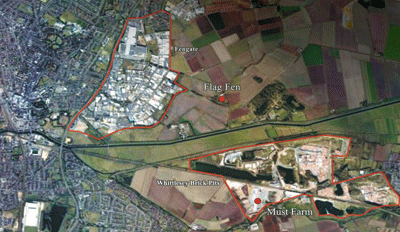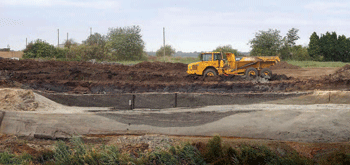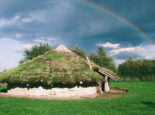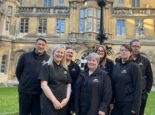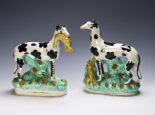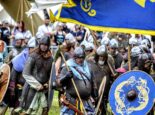A Historic Must See
A Historic Must See 1 2
FROM MUST FARM TO FLAG FEN
Both Mark and Francis are full of praise for Hanson UK who were co-operative and responsible throughout and, after the boats had been unearthed, allowed them to be stored in an old brick kiln where the temperature could be controlled and the boats could be kept wet, secure and in darkness. The next step was a more permanent home where study and proper conservation could be carried out in a more scientific environment. Flag Fen seemed the ideal location, with a large barn available – actually built by Francis – that had previously proved its preservation worth by housing the Seahenge timbers discovered in Norfolk during the first decade of the this century before they were moved to Lynn Museum in King’s Lynn. A large specialist cold storage facility was constructed, funded by a £100,000 grant from English Heritage.
The refrigeration stops the boats drying out too quickly so they can be further studied and stabilised. Over a two-year period, the boats are treated with polyethylene glycol (known as PEG), a specialist wax that has also been used to preserve Seahenge and the Mary Rose. This part of the project will be overseen by Ian Panter and his team from the York Archaeological Trust. Ian is regarded as one of the top experts in this field. Previous log boats have been cut into pieces to conserve them, but this technique will allow the Must Farm ones to stay completely intact.
With the largest of them being nine metres long, that’s quite some achievement and one that should allow a greater appreciation of the boats, not just as historical artefacts but as sophisticated works of craftsmanship in their own right. The cold storage unit has large viewing windows which enable views of the boats and the preservation work in progress inside. A nominal charge helps with the conservation costs.
‘It is tremendously important that the Must Farm boats were brought to Flag Fen,’ stresses Mark. ‘Because they are part of the same story. The boats’ arrival at Flag Fen represents a kind of “coming home” because both the boats and the causeway discovered at Flag Fen in the 1980s, and also on display to the public, represent novel kinds of conveyances in a landscape fast disappearing beneath rising waters. Both Flag Fen and Must Farm sit at the very edge of a lost world…’
The conservation process will reveal more about the log boats, with those studying keen to answer questions such as how they were used and why they were abandoned at that point in the river; whether just washed up there or sunk deliberately perhaps as some form of ritual or funeral ceremony. Carbon-14 tests will also give precise dates as to when they were made. A full report will appear in about a year and, laughs Francis, ‘should reveal everything you ever wanted to know about Bronze Age boatbuilding but were afraid to ask.’
Along with the other items found, they also represent compelling evidence of the mass colonisation of the wetlands as they were formed, revealing how our ancestors learned to adapt and thrive in a submerged terrain. They are an invaluable resource in teaching us about the past impacts of climate change on human society.
‘They’re more than the sum of their parts,’ muses Francis. ‘Must Farm is throwing light on Flag Fen, and likewise Flag Fen is throwing light on Must Farm. You could even say that we now know more about the Bronze Age in Peterborough than we do Victorian life in other parts of Britain. It’s astonishing.’
Although the Must Farm discoveries are the first time that so many log boats have been found together, both Francis and Mark believe this is but the tip of an archaeology iceberg.
‘If Must Farm is anything to go by, there must be hundreds, maybe thousands, of Bronze Age boats waiting to be found in the buried rivers of Fenland. This is the first find of many, I’m sure. I’m very optimistic about the future of the past in Peterborough,’ concludes Francis.
‘Either we’re bloody lucky or this is standard,’ Mark Adds. ‘The channel continues on and is ten metres across. That’s potentially a lot of boats. I think there’s a lot more to come out of this landscape. We used to think the Fens were a dark place; people lived around the edge of them and chucked spears and swords in the marsh to appease them. Obviously that’s very far from the case. This has all added a new depth we didn’t know was there. The prehistoric core of England wasn’t just Stonehenge but around East Anglia. It feels like we’ve been excavating a particularly glorious era of pre-history.’
The Cambridge Archaeological Unit intend to ensure that the site is properly explored: although the old river course has now left the brick pit as it extends at the moment, the team plan to go back even further in time and try and uncover aspects of Neolithic life, beyond 2000BC.
‘So long as there’s smoke coming out of those chimneys and bricks being made, there’s the hope of new and unique discoveries,’ concludes Francis. ‘This area has as rich a heritage as anywhere in Britain, and is what Peterborough has to offer visitors. You can go from the Bronze Age, through the Romans and the fantastic objects on display in the museum, the Middle Ages and the cathedral and Longthorpe Tower, post-medieval times with the world’s first prisoner of war camp at Norman Cross – which we dug with Time Team – and through to the railway age with the Nene Valley Railway and Railworld. Very few other places can offer you quite so much history of all periods. And that is really very special and something to be very proud of.’
Find out more…
For further information, call 01733 313414 or visit www.vivacity-peterborough.com/museums-and-heritage/flag-fen/discover-the-must-farm-boats/seeing-the-boats/
For more about Francis Pryor, archaeologist and novelist…
www.pryorfrancis.wordpress.com
A Historic Must See 1 2



